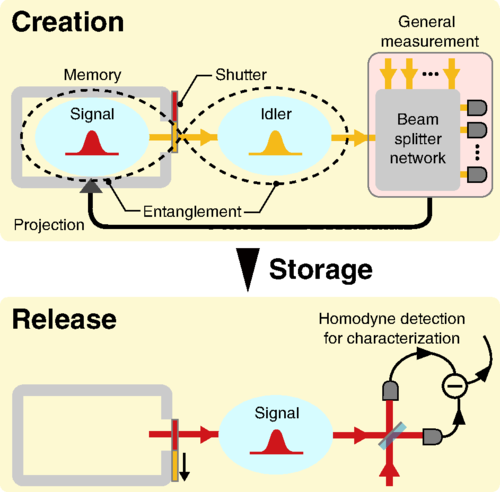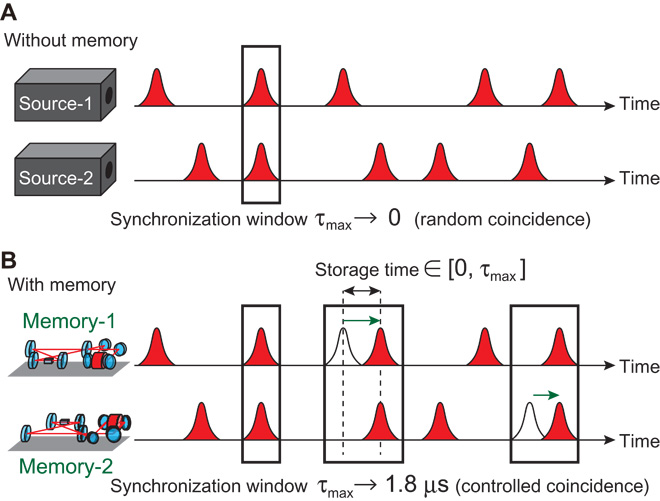Our group is conducting research on a device that can retrieve any quantum state at any time, that is, an “on-demand arbitrary state synthesizer”.
In quantum information processing, there are special states such as the cubic phase states [1] and the Gottesman-Kitaev-Preskill (GKP) state [2]. A method to realize fault-tolerant universal quantum computation beyond the classical limit by using these states has been already proposed [3]. However, these states are non-classical and non-Gaussian states, such as single-photon states, and a method called the heralding method can generate them with high purity, but only probabilistically. On the other hand, in order for quantum states of light to interact with each other, the timings at which the quantum states arrive at optical elements such as a beam splitter must be tuned. Because light always flies, it is not easy to ensure that probabilistically generated quantum states of light interact with each other.
In this context, we are now researching an innovative device that overcomes this difficulty: the “on-demand arbitrary state generator”.
In our group, a concatenated-cavity system is used as the "on-demand arbitrary state synthesizer". This system consists of two optical cavities: a memory cavity and a shutter cavity. In the system, the probabilistically generated states are stored in the memory cavity until the shutter cavity is opened.
Researches for quantum memories are actively conducted around the world [4-9]. Among them, the concatenated-cavity system used in our group has stored and retrieved single-photon states [9] and superposition states of single-photon and vacuum [10]. We have also demonstrated that it is possible to preserve the negative region of the Wigner function, a character of strong nonclassicality. The system can store any superposition of any number of photons in principle as well.
In addition, we have succeeded in controlling the emission timing of the single-photon state that exhibits the phenomenon of Hong-Ou-Mandel interference [11], and more recently, also succeeded in storing and retrieving two-mode quantum states.Currently, we are studying how to further improve the storage time of the memory and generate the state.
In order to generate a quantum state such as a single-photon state showed in the above experiment, it is necessary to measure the number of photons. The current experimental system employs a single-photon detector using an avalanche photodiode. However, this detector and most other detectors in the world only determine the presence or absence of photons and cannot count the number of them, just making it possible to generate restricted and approximate quantum states. If there would be a photon number resolving detector (PNRD), complex quantum states could be generated, leading to a giant step toward the practical quantum computation. We are collaborating with Takahashi Laboratory of Institute of Engineering Innovation (the University of Tokyo) to develop PNRDs based on a superconducting transition edge sensor.


- [1] K. Miyata, H. Ogawa, P. Marek, R. Filip, H. Yonezawa, J. I. Yoshikawa, and A. Furusawa, Physical Review A 93, 022301 (2016).
- [2] D. Gottesman, A. Kitaev, and J. Preskill, Physical Review A 64, 012310 (2001).
- [3] R. N. Alexander, S. Yokoyama, A. Furusawa, and N. C. Menicucci, Physical Review A 97, 032302 (2018).
- [4] A. I. Lvovsky, B. C. Sanders, and W. Tittel, Nature Photonics 3, 706 (2009).
- [5] Y. Y. Lai, G. D. Lin, J. Twamley, and H. S. Goan, Physical Review A 97, 052303 (2018).
- [6] C. Clausen, I. Usmani, F. Bussières, N. Sangouard, M. Afzelius, H. de Riedmatten, and N. Gisin, Nature 469, 508 (2011).
- [7] E. Bimbard, R. Boddeda, N. Vitrant, A. Grankin, V. Parigi, J. Stanojevic, A. Ourjoumtsev, and P. Grangier, Physical Review Letters 112, 033601 (2014).
- [8] M. Bouillard, G. Boucher, J. Ferrer Ortas, B. Pointard, and R. Tualle-Brouri, Physical Review Letters 210501 (2019).
- [9] J. I. Yoshikawa, K. Makino, S. Kurata, P. van Loock, and A. Furusawa, Physical Review X 3, 041028 (2013).
- [10] Y. Hashimoto, T. Toyama, J. I. Yoshikawa, K. Makino, F. Okamoto, R. Sakakibara, S. Takeda, and A. Furusawa, Physical Review Letters 123, 113603 (2019).
- [11] K. Makino, Y. Hashimoto, J. I. Yoshikawa, H. Ohdan, T. Toyama, P. van Loock, and A. Furusawa, Science Advances 2, e1501772 (2016).
